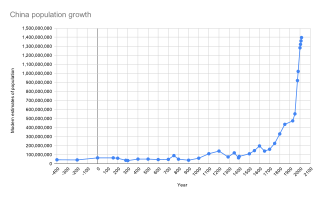
India is the second most populated country in the world with a sixth of the world's population. According to official estimates, India's population stood at 1.38 billion.

The demographic features of the population of Japan include population density, ethnicity, education level, health of the populace, economic status, religious affiliations and other aspects regarding the population.

The demographics of North Korea are determined through national censuses and international estimates. The Central Bureau of Statistics of North Korea conducted the most recent census in 2008, where the population reached 24 million inhabitants. The population density is 199.54 inhabitants per square kilometre, and the 2014 estimated life expectancy is 69.81 years. In 1980, the population rose at a near consistent, but low, rate. Since 2000, North Korea's birth rate has exceeded its death rate; the natural growth is positive. In terms of age structure, the population is dominated by the 15–64-year-old segment (68.09%). The median age of the population is 32.9 years, and the gender ratio is 0.95 males to 1.00 female. Since the early 1990s, the birth rate has been fairly stable, with an average of 2 children per woman, down from an average of 3 in the early 1980s.

The demographics of China demonstrate a huge population with a relatively small youth component, partially a result of China's one-child policy. China's population reached 1 billion in late 1981.

This is a demography of the population of South Korea including population density, ethnicity, education level, health of the populace, economic status, religious affiliations and other aspects of the population.

The demographics of Thailand paint a statistical portrait of the national population. Demography includes such measures as population density and distribution, ethnicity, educational levels, public health metrics, fertility, economic status, religious affiliation, and other characteristics of the populace.

The United States had an official resident population of 331,893,745 on July 1, 2021, according to the U.S. Census Bureau. This figure includes the 50 states and the District of Columbia but excludes the population of five unincorporated U.S. territories as well as several minor island possessions. The United States is the third most populous country in the world. The Census Bureau showed a population increase of 0.12% for the twelve-month period ending in July 2021, below the world average annual rate of 0.9%. The total fertility rate in the United States estimated for 2021 is 1.664 children per woman, which is below the replacement fertility rate of approximately 2.1.

Demographics of Wales include the numbers in population, place of birth, age, ethnicity, religion, and number of marriages in Wales.

An urban area, or built-up area, is a human settlement with a high population density and infrastructure of built environment. Urban areas are created through urbanization and are categorized by urban morphology as cities, towns, conurbations or suburbs. In urbanism, the term contrasts to rural areas such as villages and hamlets; in urban sociology or urban anthropology it contrasts with natural environment. The creation of earlier predecessors of urban areas during the urban revolution led to the creation of human civilization with modern urban planning, which along with other human activities such as exploitation of natural resources led to a human impact on the environment. "Agglomeration effects" are in the list of the main consequences of increased rates of firm creation since. This is due to conditions created by a greater level of industrial activity in a given region. However, a favorable environment for human capital development would also be generated simultaneously.
Hukou is a system of household registration used in mainland China. The system itself is more properly called "huji", and has origins in ancient China; hukou is the registration of an individual in the system. A household registration record officially identifies a person as a permanent resident of an area and includes identifying information such as name, parents, spouse and date of birth. A hukou can also refer to a family register in many contexts since the household register is issued per family, and usually includes the births, deaths, marriages, divorces, and moves, of all members in the family.

Chang is the pinyin romanization of the Chinese surname 常 (Cháng). It was listed 80th among the Song-era Hundred Family Surnames.
The first general census of the population of the Russian Empire in 1897 was the first and only nation-wide census performed in the Russian Empire. It recorded demographic data as of 28 January [O.S. 15 January] 1897.

Urbanization in China increased in speed following the initiation of the reform and opening policy. As of 2022, China had an urbanization rate of 64.7% and was expected to reach 75-80% by 2035.
Heihaizi or "black child" is a term applied in China. The term denotes children born outside the One child policy, or generally children who are not registered in the national household registration system.

The 2010 Chinese census, officially the Sixth National Population Census of the People's Republic of China (中華人民共和國第六次全國人口普查), was conducted by the National Bureau of Statistics of the People's Republic of China with a zero hour of November 1, 2010.
Earth has a human population of 7.9 billion, with an overall population density of 50 people per km2, excluding Antarctica. Nearly 60% of the world's population lives in Asia, with almost 2.8 billion in the countries of China and India combined. The percentage share of India, China and rest of South Asia in world population have remained on similar levels for the last few thousands years of recorded history. The world's literacy rate has increased dramatically in the last 40 years, from 66.7% in 1979 to 86.3% today. Lower literacy levels are mostly attributable to poverty. Lower literacy rates are mostly found in South Asia and Sub-Saharan Africa. The world's largest ethnic group is Han Chinese, with Mandarin being the world's most spoken language in terms of native speakers.
The 1964 Chinese census, officially the Second National Population Census of the People's Republic of China, was conducted by the People's Republic of China with a zero hour of 1 July 1964. The results of the census were not publicized and its very existence was not officially acknowledged until the early 1980s.

The 2010 census put Shanghai's total population at 23,019,148, a growth of 37.53% from 16,737,734 in 2000. 20.6 million of the total population, or 89.3%, are urban, and 2.5 million (10.7%) are rural. Based on population of total administrative area, Shanghai is the second largest of the four direct-controlled municipalities of China, behind Chongqing, but is generally considered the largest Chinese city because Chongqing's urban population is much smaller.

The Seventh National Population Census of the People's Republic of China, also referred to as the 2020 Chinese Census, was the seventh national census conducted by the National Bureau of Statistics of the People's Republic of China. Census work began on November 1, 2020 and continued through December 10, 2020, involving seven million census workers.

The population history of China covers the long-term pattern of population growth in China and its impact on the history of China. The population went through many cycles that generally reached peaks along each imperial power and was decimated due to wars and barbarian invasions. The census data shows that the population as percentage share of the world has a long-term average of 26%, with 6% standard deviation. The minimum could be as low as 16% while the maximum as high as 33%. In the late 20th century and the early 21st century, the percentage share has been trending down. This was caused by two opposite factors: On one hand, the world population has been growing explosively. On the other hand, in order to address the poverty issue, China implemented a strict birth control policy. For recent trends see demographics of China and China.














